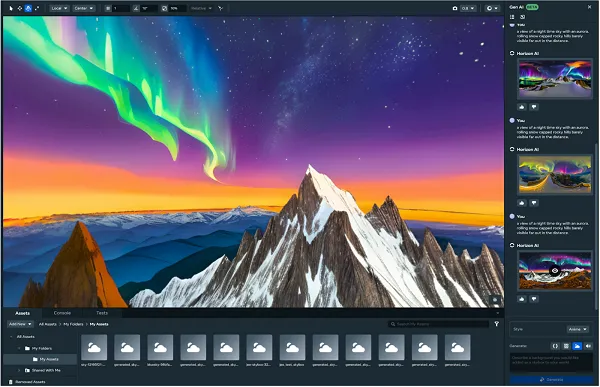# Meta Outlines Advancing 3D Object Creation Course of

Meta has outlined the subsequent factor of its evolving VR asset era mannequin, which is able to allow any VR person to create a completely immersive setting, by merely talking issues into existence.
Referred to as AssetGen, Meta’s newest system permits VR customers to create complicated 3D objects from textual content and picture prompts.

As you’ll be able to see on this instance, AssetGen is an advance in 3D world era, by enabling customers to construct out their experiences with complicated, high-quality 3D gadgets.
As defined by Meta:
“Constructing on its predecessor, AssetGen 1.0, our newest innovation represents a big leap ahead in 3D generative AI analysis, leveraging a single-stage 3D diffusion mannequin to ship 3D meshes with dramatically improved element and constancy, whereas our complementary TextureGen mannequin ensures that these property will not be solely visually beautiful but additionally production-ready with high-quality textures.”
Meta says that AssetGen 2.0 makes use of 3D diffusion for geometry estimation, and is skilled on a big corpus of 3D property.
“For texture era, it additionally introduces new strategies for improved view consistency, texture in-painting, and elevated texture decision. We’re at the moment utilizing AssetGen 2.0 internally for 3D worlds creation, and we’ll roll out later this 12 months to Horizon creators.”
That, successfully, will democratize VR creation, enabling anybody to create complete, immersive VR experiences, by merely talking them into existence.
Meta’s been growing simplified 3D creation instruments over the previous few years, showcasing its preliminary VR “BuilderBot” again in 2022.
AssetGen is a part of the subsequent iteration of this, with Meta showcasing its increasing VR inventive capability final month, which already permits the creation of full VR worlds via textual content and spoken prompts.

With this, anybody can successfully create their very own VR setting inside hours, with out the necessity for coding information or in-depth understanding of VR methods.
That, as famous, is the subsequent stage of Meta’s VR evolution, and the gateway into its broader metaverse expertise.
Which, logically, stays the most certainly subsequent advance for connective expertise, although there are nonetheless a number of hurdles that may impede that subsequent stage, which may very well be tough to beat.
For one, Meta must facilitate widespread adoption of VR, and VR headsets aren’t low cost. Meta has stated that it’s prepared to take a success on this, consuming among the value of unit gross sales in an effort to increase Quest take-up. However even then, the present slate of VR experiences might be not sufficient to drive widespread adoption as but.
Although take-up is steadily growing.
Meta is promoting extra Quest headsets over time, however once more, it’s not near being a “must-have” tech merchandise as but.
Which is why Meta’s shifted its focus to AR glasses as a substitute, which may now facilitate using AI prompts at any time. And with AI being the tech pattern of the second, that’s serving to to spice up gross sales of Meta’s Ray Bans, which it sees as a stepping stone into its full VR expertise.
And while you additionally take into account the adoption of on-line gaming worlds as a key connective platforms for thousands and thousands of kids, that’s another excuse to consider that this method is the subsequent logical development, although there may be one different vital subject that Meta nonetheless must resolve: Movement illness in VR environments.
When you use immersive VR for greater than half-hour, your physique’s going to be compelled to regulate to a mixture of unnatural responses, primarily based on the inputs that you simply’re experiencing. That, for some folks, will result in movement illness, with round 1 / 4 of all VR customers feeling just a little inexperienced because of the shift.
Personally, I felt instantly sick in a rollercoaster VR sim, whereas an area setting was additionally disorienting. I imply, I get sick on precise rollercoasters, and there may be some proof to counsel that older customers usually tend to really feel such impacts. As such, I might not be the very best instance, however there’s a actual concern about VR illness, and the way that may be overcome to facilitate broader adoption and use.
As a result of whereas having the ability to expertise immersive environments is one factor, getting your physique to return alongside for the trip is one other, and Meta nonetheless has some challenges earlier than it on this respect.
Perhaps that’s simply a part of the broader evolution, of human evolution extra broadly, and the subsequent era might be extra attuned to such, as they interact in VR from youthful ages.
However mainly, Meta’s nonetheless received a approach to go to make its VR metaverse a factor. Which is why it in all probability went too early with the general public identify change to Meta (although it has had different model affiliation advantages), which has prompted many to counsel that its metaverse dream is a failure.
It’s not, it’s simply not right here fairly but. However advances like this are one other vital step in the direction of facilitating partaking, enriching VR experiences.
Andrew Hutchinson




